Dec 10, 2014 | bullion, coins, Eagles, halves, silver, US Mint
A couple of quick news items that came out of the U.S. Mint on Tuesday.
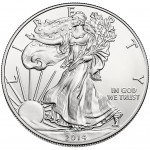 The U.S. Mint reported that as of December 8, 2014, they had sold a record 42,864,000 one troy ounce American Silver Eagle Bullion coins for all of 2014. This beats the previous record of 42,675,000 coins sold in 2013. Sales of the 2014 bullion coins to authorized dealers will end during the week of December 15.
The U.S. Mint reported that as of December 8, 2014, they had sold a record 42,864,000 one troy ounce American Silver Eagle Bullion coins for all of 2014. This beats the previous record of 42,675,000 coins sold in 2013. Sales of the 2014 bullion coins to authorized dealers will end during the week of December 15.
Taking a sample of five different bullion dealers, the average price is around $20 for one American Silver Eagle Bullion coin. If each coin is worth about $20 each, that means the U.S. Mint sold $857.28 million in silver bullion for 2014. Remember, this is for the bullion coin. This does not count the collectible versions such as the proof or the West Point struck uncirculated coin.
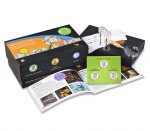 The other announcement was that the U.S. Mint will sell a new product, Coin Discovery Set — An Introduction to Coin Collecting. The set costing $24.95 will include three 2014 Kennedy Half-Dollars in three different finishes—proof, uncirculated and circulating. It will also include two coin tubes for quarters, a magnifying glass, cotton gloves, and a booklet that explains the coin production process. The box will the the size to store U.S. Mint proof sets.
The other announcement was that the U.S. Mint will sell a new product, Coin Discovery Set — An Introduction to Coin Collecting. The set costing $24.95 will include three 2014 Kennedy Half-Dollars in three different finishes—proof, uncirculated and circulating. It will also include two coin tubes for quarters, a magnifying glass, cotton gloves, and a booklet that explains the coin production process. The box will the the size to store U.S. Mint proof sets.
Sales will open at noon Eastern Standard Time (1600 UTC) on Tuesday December 16, 2014. While there will be no household ordering limit, the U.S. Mint has set a product limit to 45,000 sets.
Images courtesy of the U.S. Mint.
Dec 9, 2014 | coin design, coins, commemorative, medals
I know it has been a while since I wrote a substantive post. But as the holiday season is upon us, business has picked up and I am doing a lot of buying and selling. While good for business, it has not provided me time to write. I have a backlog that I will get to, so please be patient.
Of the items I am buying and selling are Challenge Coins. While not coins in the strictest sense of the term challenge coins are the size of large dollar coins or crowns issued, usually issued by a military organization and given to someone as a sign of appreciation. Back in 2009, I wrote about NBC news anchor Brian Williams admitting that he collected challenge coins.
Although given in appreciation, not everyone appreciates their significance and, in some cases, their beauty. Aside from finding them in estate sales, they are included in large lots of items I purchase while looking for other items. For some reason, the sellers throw them into the lot thinking that they are not worth much.
For the most part, challenge coins do not have value the way coins have value. Most challenge coins are enameled bronze disks. What makes them interesting is the topic, the location depicted, or who issued the coin. Some challenge coins are very basic while others have artistic value that rivals anything issued by government mints.
Although I have handled hundreds of challenge coins in the last year, two stand out as exception. Unfortunately, I was so excited to have found them that I sold them to new owners before taking pictures. One was a coin that was overlaid on a large “V” which was to be the Roman numeral for five. It was very striking. The other was a coin that was three-inches wide by one-inch tall in the shape of a dog bone. This very unique challenge coin was issued for an anniversary of the police canine unit of Amtrak in Chicago. Aside from various insignias and images of the five types of dogs that Amtrak Police Canine Unit trains, the coin included representative flags including one for the City of Chicago.
Here are some challenge coins that I have recently sold:
U.S. Army Garrison Natick Challenge Coin
Presented for Excellence by the Garrison Command Team in Natick, Mass.
U.S. European Command (USEUCOM) Headquarters Challenge Coin
Presented by the Deputy Command in Chief C.S. Abbot, Admiral, U.S. Navy
Rear Admiral Charles S. Abbot (ret.) was Deputy Commander in Chief of USEUCOM from 1998 to 2000.
78th Troop Command Challenge Coin
“Georgia’s 911 Force”
The 78th Troop Command is the Georgia National Guard. Coins was presented by the Sargent Major (see the insignia on the reverse).
United States Forces Korea Challenge Coin
50th Anniversary of the Korean War Commemoration
Federal Bureau of Investigation Challenge Coin
100th Anniversary of the FBI
Finally, if you want to start your own challenge coins collection, here are a few I have for sale for you to start:
Nov 27, 2014 | celebration, coins, commemorative
1920 Pilgrim Tercentenary Half Dollar Commemorative
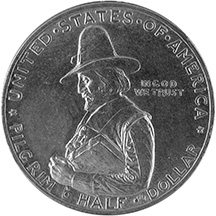
This coin commemorates the 300th anniversary of the landing of the Mayflower. The image is of a pilgrim carrying a Bible.
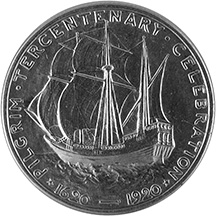
The image is of the Mayflower, the ship that brought the pilgrims to Massachusetts.
Thanksgiving in the United States is usually traced back to the Pilgrims celebration of their first successful harvest in 1621. The three-day event was attended by 53 Pilgrims and 90 Native Americans that lasted three days. The tradition of giving thanks for successes was a tradition that the Pilgrims brought with them from England. This three-day celebration in 1621 is considered the first Thanksgiving.
Although there is no record of the menu, it is likely that the meal consisted of food from the harvest, venison, and Indian corn. The local natives killed five deer as gifts for the celebration. Given the abundance of seafood nearby, it is likely some made it to the celebration as well.
Thanksgiving was celebrated during many different times within the colonies, mainly to give thanks for something that was honorable to the colony or the locality that observed the celebration. The first national recognition of a Thanksgiving celebration came when General George Washington declared December 1777 as Thanksgiving honoring the defeat of the British at Saratoga. As President, George Washington declared the first national Thanksgiving celebration on November 26, 1789. The only other president to issue a Thanksgiving proclamation was President James Madison. From then, it was up to the individual states to declare a Thanksgiving holiday.
After reading a diary from the time of the Pilgrims, writer and editor Sarah Josepha Hale wrote editorials campaigning to bring back the Thanksgiving celebration. As part of her efforts Hale developed recipes for roasted turkey, pumpkin pie, and stuffing that are part of the inspiration for today’s Thanksgiving feast.
Hale’s message made it to the White House where it was embraced by President Abraham Lincoln. As part of his attempt to maintain the union, President Lincoln issued a proclamation that made Thanksgiving Day a national annual event on the last Thursday in November beginning in 1863.
You might not have heard of Hale but you might know one of her most famous poems. In 1830, Hale published Poems for our Children that included one originally titled “Mary’s Lamb.” Today, it is more commonly known as “Mary Had a Little Lamb.”
Thanksgiving remained the last Thursday of November until 1939 when he declared Thanksgiving to be on the fourth Thursday of the month to give merchants more time to sell good during the Christmas shopping season. Congress passed a joint resolution in 1942 fixing Thanksgiving to the fourth Thursday of November.
In 1947, the National Turkey Federation has provided the President of the United State with one live turkey and two dressed turkeys. President Harry Truman is credited with pardoning the first turkey in 1947 but it did not become a tradition until President Ronald Reagan started in 1987 and continued by President George H.W. Bush in 1989. Since 1989, the pardoned turkeys have lived the rest of their lives at Frying Pan Park in Herndon, Virginia.
Happy Thanksgiving!
Nov 18, 2014 | advice, auction, cents, coins
 Over the weekend I attended an estate auction that included coins for sale. While my new business venture concentrates on all vintage collectibles, I am still a collector and continue to look for those interesting items and the good coins to add to my collection. As I was looking over the lots I noticed one had several blue folders of Lincoln cents. The collector in me could not resist and I picked up the folders and started looking.
Over the weekend I attended an estate auction that included coins for sale. While my new business venture concentrates on all vintage collectibles, I am still a collector and continue to look for those interesting items and the good coins to add to my collection. As I was looking over the lots I noticed one had several blue folders of Lincoln cents. The collector in me could not resist and I picked up the folders and started looking.
Every hold was filled.
What drew my eye first was the hole marked “1909-S VDB.” Even though the 1914-D may be worth more, the 1909-S VDB is considered the Holy Grail amongst change hunters. With only 484,000 struck the odds of finding one are not in a change hunter’s favor. But we keep looking and hoping.
After reaching into my pocket for my ever present loupe, I asked the attendant if I could remove the coin to see the reverse. I had to check for those three letters on the back because it did say it was a 1909-S on the front. With the attendant watching me, I removed the coin from the slot, turned it over and brought it up to my loupe.
Using a 16X loupe I zeroed in on the area where I could find the “V.D.B” only to find something unexpected. On this coin, the “VDB” with no periods were punched into the coin. Holding the coin and turning it in the light to see how the light reacts, it was easy to see that the coin was not real.
Being very disappointed I quietly told the attendant that the coin was altered. She did not know what to do. When I suggested she tell her boss, she took the coin from me and went into a back room. A moment later, she returned and asked me to follow her to the office.
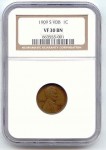
Scott’s 1909-S VDB
I understand how he felt. In the auction business, they earn money from the buyer and seller fees. If the item sells for a high price, the auction house makes more money. In this case, since the coin was a solid VF, it could have sold for $700-800 alone.
Before he became too angry, I asked to see the 1914-D. At VF that coin is about $400 in the retail market. When I looked carefully I could see that the mintmark was added to the coin. It was not a very good job when you see it under magnification but looked all right on first glance. I showed the auctioneer how I know it had the mintmark added. He agreed with my assessment.
He asked if there were any more important dates that he should know about. I zeroed in on the hole for the 1922-D that had “No D” written in pen under the date. Even before finding the date under the loupe I could tell the coin was whizzed. That is a bad sign to begin with but if the coin was real, it would diminish its value but not make it worthless. What made it worthless was that you can tell someone filed the mintmark off the coin. Whoever did the filing did not do a good job because it made a little hole where the mintmark should be. This coin doctor probably whizzed the coin in order to cover up the alterations.
To say I gave this gentleman a shock would be an understatement. He shook my hand and offered me a discount on the buyer’s fee for helping him. After leaving his office he had the attendant who helped me remove all of the blue binders from the auction. When I spoke with the attendant later, she said they were all from the same consignor and that he was going to return them as being unsalable.
This was not the first time I attended an auction at this place and it will not be my last. Aside from being able to purchase good inventory for my business, they have proven to me they have integrity. Knowing this helps me buy with confidence.
I tell this story to provide two lessons. First, always examine the items before you bid. Even for online auctions, examine the pictures and read any descriptions carefully. If you are afraid to buy ungraded coins, then buy only graded coins. But make sure you are fully aware of what is being sold. Do not be afraid of asking the seller a question or even asking for a better picture. If the seller cannot help you then do not buy from that seller.

Buy the book before buying the coin!
My second lesson is to know who you are buying from. This is more difficult online but you do have to take the feedback seriously. Again, if you have any questions you should ask. Every site has a way to contact the seller in order for you to ask questions. If the seller is not cooperative, let that be a sign for you.
When working with auction houses, it takes a little longer to establish a relationship. But you need to introduce yourself, talk with people and ask questions. Make yourself known and show that you are a serious buyer. It may take a few auctions to establish a relationship, but be persistent. Aside from preferential treatment and discounted seller fees, someone with a relationship can be told bout unpublished items in advance so that you are prepared to buy quicker than someone off the street. Another advantage is that if you specialize in something that the auction house cannot sell, you can buy it as a good price. As a reseller, I find that very good for business.
Even though online auctions are very popular, there is nothing better than being there live. I highly recommend the experience.
Nov 13, 2014 | coins
 Although the numismatics industry generates millions of dollars per year, it is dominated by small businesses. You can see this by going to any show and with the exception of the major auction and bullion companies, the vast majority of the dealers you see on the bourse floor are small businesses. Numismatics may be one of the few national industries that you can meet the owner just by walking up to their table at a show.
Although the numismatics industry generates millions of dollars per year, it is dominated by small businesses. You can see this by going to any show and with the exception of the major auction and bullion companies, the vast majority of the dealers you see on the bourse floor are small businesses. Numismatics may be one of the few national industries that you can meet the owner just by walking up to their table at a show.
Numismatics is not alone as being dominated by small businesses but it is the only industry that generates notice because of the prices for its high end merchandise. Face it, some people cannot comprehend how someone can pay over $10 million for a one dollar coin. Forget the fact that the coin may be amongst the first dollars produced by the U.S. Mint, it is still just a one dollar coin.
We keep hearing that small businesses are the backbone of the economy and that Main Street does not function without small businesses. Small businesses have been using the modern equivalence of mail order in order to expand beyond Main Street to reach customers where ever they are. In the spirit of Aaron Montgomery Ward and Richard Warren Sears whose mail order catalog businesses are the legends of business history, modern entrepreneurs have been leveraged the Internet to sell goods and services to a worldwide public.
Even though the small business is the backbone of the economy, their existence is constantly under attack. Aside from over regulation and complicated tax requirements, states want these small businesses to now collect sales taxes from the customers in the states that require sales taxes. This is not limited to sales by catalogs and the telephone. Sales made using the Internet would be subject to the customer’s sales tax.
In other words, as a small business owner in Maryland but I sell a coin to someone in Virginia I would have to collect the sales tax for the Commonwealth of Virginia. The same would be true if I sell a coin to someone in the District of Columbia or the State of New Jersey. However, if I sell the same coin to someone in Delaware I would not have to collect sales taxes since it is not required by Delaware.
This also does not count the states that collect sales taxes for the sale of coins but not the sale of bullion or for coins over a certain threshold. A small business now has to add additional resources to comply with the laws of all 50 states even though they are present in only one.
The Senate passed the Marketplace Fairness Act (S. 734) with objection from the senators representing states that do not have sales tax laws. In the House, Judiciary Committee Chairman Bob Goodlatte (R-VA) has been a vocal critic of the bill. Goodlatte has said that the bill is written too broadly and could damage online commerce.
Although the bill was called the Internet sales tax bill, the bill was written in such a way to require all interstate sales to be subject to the collection of sales taxes. Collecting of sales tax would include everything from services to advice as well as digital downloads including music, smartphone apps, and streaming music services.
On Monday, all small businesses breathed a sigh of relief when a spokesman for Speaker of the House John Boehner (R-OH) said:
The speaker has made clear in the past he has significant concerns about the bill, and it won’t move forward this year. The Judiciary Committee continues to examine the measure and the broader issue. In the meantime, the House and Senate should work together to extend the moratorium on internet taxation without further delay.
This does not mean the Senate has given up. Sen. Mike Enzi (R-WY) has attached the wording of the Marketplace Fairness Act to a bill that passed the House to extend a moratorium on taxing Internet access. Although this has some support from Sen. Orin Hatch (R-UT), ranking member on the Senate Finance Committee, Chairman Ron Wyden (D-OR) is against the bill since Oregon is one of the states that does not have sales tax laws.
With the Democrats facing the loss of control of the Senate in January, it may be unlikely that the Democratic chairman of a committee would give a Republican something he wants during a lame duck session. Wyden will block the measure and work with Majority Leader Harry Reid (D-NV) to promote their agenda before they lose control.
But for now, you can order coins from your favorite out of state dealer or even from your favorite auction website without having to worry about having to add sales tax to your purchase.
Nov 6, 2014 | bullion, coins, commentary, gold, US Mint
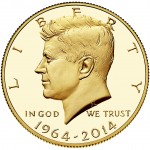 Every Thursday morning, the U.S. Mint looks at the afternoon London Fix price of gold and adjust their bullion-related coins based on their published tables. This morning, the U.S. Mint adjusted prices after noting that the afternoon London Fix priced gold at $1,145.00 per troy ounce. Based on the table published in the Federal Register, the price of the 50th Anniversary Kennedy 2014 Half-Dollar Gold Proof Coin was reduced to $1,165.00!
Every Thursday morning, the U.S. Mint looks at the afternoon London Fix price of gold and adjust their bullion-related coins based on their published tables. This morning, the U.S. Mint adjusted prices after noting that the afternoon London Fix priced gold at $1,145.00 per troy ounce. Based on the table published in the Federal Register, the price of the 50th Anniversary Kennedy 2014 Half-Dollar Gold Proof Coin was reduced to $1,165.00!
Please pardon me as I laugh at all of those dealers whose questionable ethics caused despicable scenes in Philadelphia, Washington, Denver, and Rosemont at the ANA World’s Fair of Money when the introduction price was $1,240. Those who have waited to order the coin directly from the U.S. Mint for a coin that does not have a mintage limit will have saved $75 from the issue price. And by buying from the U.S. Mint, you do not have to pay the alleged “numismatic premium” dealers will apply for the special label encased on the plastic they paid to have the coin entombed in.
Regardless of what the politicians say, some business pundits recognize that the economy is moving forward and the stronger dollar will continue to push prices lower.
If the price of gold drops below $1,100 by next Wednesday afternoon’s London Gold Fix, the price of the Kennedy gold halves will drop to $1,127.50. If that happens, I will be back to laugh even more!
Oct 31, 2014 | ANA, CCAC, coin design, coins, commemorative, commentary, gold, halves, medals, policy, silver, US Mint
 It has been a few years since I did an All-Hallows-Eve numismatic trick-or-treat that it seems like a good time to do add one. Here are my numismatic tricks and treats for this past year.
It has been a few years since I did an All-Hallows-Eve numismatic trick-or-treat that it seems like a good time to do add one. Here are my numismatic tricks and treats for this past year.
Girl Scouts need a values adustment
TRICK: It was announced in January that the 2013 Girl Scouts commemorative coin did not generate enough sales for the U.S. Mint to provide a payout of seignorage. This is the first time this has happened. Part of the problem was that the Girl Scouts are stuck in the 1950s mindset that does not see collecting coins as a girl’s hobby. Although values are important, this shows that he Girl Scouts’ values are behind the times and will not be the catalyst behind helping expand the hobby. They should be ashamed for contributing to this failure.
ANA Willfully Gives up its Premier Status
TRICK:The Professional Numismatists Guild and the American Numismatic Association announced in January that “the first” PNG-ANA Numismatic Trade Show the weekend prior to the 2014 World’s Fair of Money in Rosemont that it will be open to the public. While making it sound exciting it made the entire show 8-days long. This was a bad move because of the length and because it makes the ANA play second to PNG. If the ANA wants to be the premier numismatic organization, the one that anyone wanting to learn about and be about numismatics, The ANA should not play second fiddle to any other organization.
There are coin treats!
TREAT:In creating a tribute to the 50th anniversary of the Kenney half-dollar, the U.S. Mint has made a coin that is not really circulated into something interesting for the collector. The dual-dated gold coin became an instant hit before the price of gold dropped and the silver sets are reportedly selling well. This was a good move by the U.S. Mint.
TREAT:For the most part, commemorative coins are sales do not meet expectation. While there are a few exceptions like 2005 Marine Corps 230th Anniversary silver dollar, most commemoratives do not come close to their maximum mintage. But the 2014 National Baseball Hall of Fame commemoratives appear to have hit a home run. The combination of the subject and the curve of the coin may be a significant factor in the coin’s success. The $5 gold and silver dollar coins are both sold out. There are some of the clad half-dollars available.
TREAT:Speaking of cool stories, what about the Saddle Ridge Hoard? After a couple found the hoard of gold coins while walking their dog, it spawned an interest in metal detectors and searching for buried treasure. It was such an amazing story that it even found its way into the national news cycle. But like everything else, another shiny story diverted the media’s attention and the coins went on sale to the general public on Amazon.com.
Not all coins are treats
TRICK: Colored and coins with gimmicks are proliferating in the market. So far, the U.S. Mint and the Royal Mint are resisting colored and other gimmicks while the Royal Candian Mint and New Zealand Mint are at a race to the bottom for gimmick coins.
Numsimatics and technology
TREAT: The ANA launched its new website with new technology ready for growth on time and under budget. This is the website that ANA Governor Laura Sperber said, “I can’t wait to see what a disaster the ANA new web site will be.” So far, there has not been a follow up from Sperber while the new site has been a success.
TREAT: More recently, the U.S. Mint had a great launch to their new website. After years of frustration with the online ordering of what would be popular items, the new site handled the launch of the 50th Anniversary Kennedy 2014 Half-Dollar Silver Coin Collection with no issues.
Failure to launch
TRICK: The U.S. Mint launched the Baseball Hall of Fame commemorative coin at the Whitman Show in March not anticipating its popularity with fewer coins that there was a demand. It was as if the U.S. Mint had a blind spot with how popular this coin would be.
TRICK: The dealers who paid less than desireable people uninterested in anything other than a quick buck to mob the lines at the Denver Mint and the World’s Fair of Money. I continue to belive that their ethics must be questioned and appropriate actions taken by the ANA even though I do not think that will happen.
TREAT: With the drop in the price of gold, the current price of the gold Kennedy half-dollar tribute is less than what is was at launch. Teach these greedy dealers a lesson and buy the coins for less directly from the U.S. Mint!
U.S. Government hands out coal
TRICK: Because the U.S. Mint can only do what the laws that congress pass tells them they can do and congress is so dysfunctional they cannot even pass laws for issues they agree on, the United States was the only country involved with the Allies on D-Day NOT to issued a commemorative to honor the 70th anniversary of D-Day.
TRICK: In the name of political correctness, the State Department’s Cultural Property Advisory Committee (CPAC) continues to make it difficult for ancient coin collectors to participate in its hobby by allowing countries to ask the State Department to overreach on the enforcement on the Cultural Property Implementation Act. It is turning ancient coin collectors into criminals even for collecting common coins. Their actions are rediculous.
CCAC is the CCAC
TREAT: The Citizens Coinage Advisory Committee suggested creating American Arts medals that will feature the artistic ability of the U.S. Mint’s artist.
TRICK: The arts medals are medals, not coins. Even with the beauty of medals like the 9/11 silver medal, it did not sell like coins would. In fact, it grossly under performed without raising significant sums for the 9/11 Memorial at the site of the Twin Towers in New York. But this is what the CCAC is face with because of congressional dysfunction (see above).
So goodbye everybody, and remember the terrible lesson you learned tonight. That grinning, glowing, globular invader of your living room is an inhabitant of the pumpkin patch, and if your doorbell rings and nobody’s there, that was no Martian… it’s Hallowe’en.
— Orson Welles, The War of the Worlds, CBS Radio, October 30, 1938

Hobo Ike and Jefferson courtesy of Darth Morgan posted at
Coin CommunityOct 29, 2014 | coins, halves, silver, US Mint
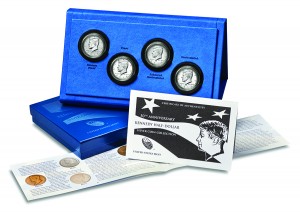
2014 Kennedy 50th Anniversary Silver Collection
Each of the four coins will have different finishes. There will be one reverse-proof coin from West Point, a proof coin from Philadelphia, and uncirculated coin from Denver, and an enhanced uncirculated coin from San Francisco. The enhanced uncirculated coin will be struck on dies that will use a laser frosting and special wire brush treatments to enhance the design. The wire brush treatment is something new to the U.S. Mint that has not been seen on any publicly released coins or medals.
What is even more impressive is that the new computer ordering system withstood the challenge of a new product offering. In years past, the computer ordering for popular U.S. Mint products had sent the computer system into fits while trying to keep up with the requests. By all accounts, the computer system not only processed every order in a timely manner, but the U.S. Mint reports that the site was working at a rate of 14 orders per second and that the average peaked at 24.9 orders per second.
Orders for the set began at noon and after a half hour, 36,000 units were sold translating into $3.6 million in sales. As of midnight, 12 hours after opening the sale, the U.S. Mint sold 85,670 sets. The U.S. Mint is reporting that by 8:30 PM, they shipped 14,000. They started with 180,000 sets in stock which means there is time to order yours and to have it processed quickly.
For those of us who suffered through the pain of ordering of products line the American Eagle 25th Anniversary Silver Coin Set, the performance of the new website is a welcome change.
While the new website looks good and sports more modern functionality, it seems to perform well and works more smoothly than the old site. Unfortunately, I am not sure that I like the way the site is organized. My primary complaint is that the site is designed as a shopping site that seems to have buried the information about the coin programs. There should be a better balance between their mission as the government’s manufacturer of coins and the sales of those coins.
After years of frustration with the U.S. Mint, it looks like they are really working to serve its clientele including the Federal Reserve, which it is required to produce coins for by law. Maybe it has served the country well by having a professional run the U.S. Mint rather than a politician.
Oct 25, 2014 | coins, commentary, ethics, grading
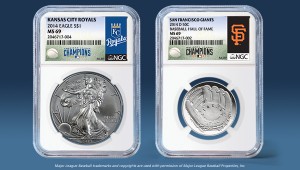 Fans of coins encased in plastic with special labels who also are baseball fans must be ecstatic that Fans of coins encased in plastic with special labels who also are baseball fans must be ecstatic that Numismatic Guarantee Corporation and Major League Baseball agreed to an exclusive deal that will allow NGC to reproduce team names, logos, and stadiums on labels used in NGC slabs.
Fans of coins encased in plastic with special labels who also are baseball fans must be ecstatic that Fans of coins encased in plastic with special labels who also are baseball fans must be ecstatic that Numismatic Guarantee Corporation and Major League Baseball agreed to an exclusive deal that will allow NGC to reproduce team names, logos, and stadiums on labels used in NGC slabs.
NGC announced that they will “encapsulate the National Baseball Hall of Fame commemoratives and other legal tender coins with attractive certification labels that feature a range of popular MLB trademarks.” Aside from the Major League Baseball logo, the logos of the 30 clubs, and stadium images, it will also include logos of All-Star Game and those used for post season.
NGC says this is gives their customers “an exciting new opportunity to combine their passions for the sport and the hobby.” What it gives is NGC a new area for marketing and to extract money from the market.
I understand that NGC is a business and has owners that are concerned about the business generating revenues. But what this will do is increase their revenues at the risk of some of the protections they claim is good for the hobby by encouraging cracking slabs, thus making the population reports even less reliable than they are today.
Let’s consider that I am one of those odd people that happens to collect the coin but it happens to be in a slab to ensure that it is genuine and the grade is something agreeable. This is a really nice coin and it fits in with my collection. But the coin happens to be in a slab with the logo of the New York Yankees. I hate the Yankees. I despise the Yankees. I have hated the Yankees ever since my father, the Brooklyn Dodgers fan, taught me to say “Let’s Go Mets!”
Unlike the fans of plastic, I really consider the coin encased in the slab. It is possible that I may like a coin even with the consequence that the label inside that slab has a decoration I am allergic to. If I decide that the coin is worth purchasing even if I ignore the label, I will buy the coin, but that label will have to go. There is no question that when I bring the coin home, the slab will be cracked, the coin removed, and the label finding its way to an appropriate disposal fitting of my opinion of that team.
Once cracked out of the slab, I could send it back to NGC and just have them re-grade the coin an put it in a plain slab. I could send it to Professional Coin Grading Service to see if they will give me a more solid grade. If it is a Morgan dollar I can ask ANACS to attribute the VAM. I could also ust keep it as a raw coin. Since the vast majority of my collection is not slabbed, this is not a problem. Besides, I know it is genuine because NGC slabbed it and I could submit it later if I need it slabbed again for resale.
Frankly, how many people actually save the labels and report their crack outs to the grading services? In the few cases when I have cracked coins out of its plastic tomb, I have not reported the cracked out coin to NGC. They have been cracked out of the slabs from multiple companies and submitted to NGC at a time I was working on a registry set. I believe this will encourage cracking out of the slab and make the population reports less reliable than they are today.
Not only will this affect the grading service population reports but it could affect coins with Certified Acceptance Corporation stickers. My hatred of the Yankees will not have me think twice about cracking that plastic just because the CAC or anyone else put a sticker on the slab. If I am not telling NGC I obliterated their label, I am not reporting it to CAC either—especially since I am not exactly a fan of CAC.
I do not begrudge NGC for doing what they need to do to earn a living. But they need to explain how these gimmicks align with their uncompromising standards and a commitment to integrity. Just admit that these gimmicks are being used to improve revenues and that everything else is window dressing. I would respect the honesty.
Image courtesy of NGC.
Oct 23, 2014 | coins, commentary, education, medals, tokens
Advancements in all areas of life, whether it is the cars we drive, the entertainment that we like, how we shop, and where we get our news are inevitable. Where the car I drove in college had a the classic Chrysler Slant 6 engine with nothing electronic, I now drive a Chevy pickup with a Vortec V8 with variable timing controlled by a computer that will even start with the push of a button on my key fob.
Rather than complain about these changes, I try to embrace them as progress. After all, I started programming computers by punching cards in the 1970s. Today, the smartphone in my pocket has more computing power than anyone could have imagined while feeding our cards through the reader waiting for output on green bar paper.
Because I like to be progressive with technology and feel that not only have I seen a lot but that I adjusted, I tend to look down on those who cannot. I know that it may be elitist and contemptuous on my part and I should be more understanding, especially now that I bought a car with a Slant 6 as a toy and want another car without all of the electronics.
This self examination was prompted by an article by Q. David Bowers that appeared online on the Coin World website. In the article, Bowers reflects back as to how the hobby has changed since he started writing his column in 1961 and what it is today.
Basically, you used to have to know more about numismatics. You had to know what you were looking at in order to grade coins, know where to find the prices, have the education to know what is fake and what is not, and have a trusted dealer that you can go to to help you with your collection. It was a lot like my Slant 6 in that while the dealer would help, I had to know more about the car in order to keep it running, especially as a poor college student.
Today, Bowers says it succinctly, “No knowledge is necessary!”
While this can help grow the hobby, it makes it just a bit colder. You do not need a dealer when the Internet will do. You do not need the knowledge when companies will entomb a coin in plastic, say it is genuine, and assign a grade so you know what its state of preservation is. If the plastic is not enough, you can even find someone to place a sticker on the plastic to bless that the plastic is good. Then the sticker placer will buy the plastic to churn the market that will essentially drive up the prices.
Although the grading services do provide a service that guarantees the coin’s authenticity, they have also created a fervor over plastic that caused the the despicable behavior during the launch of the Kennedy gold tribute coin.
“If you are typical, quality means nothing. The label on a holder takes care of everything,” writes Bowers. Sadly, he is right because people are no longer collecting coins. They are collecting plastic and stickers while watching online price guides the way day traders watch stock prices. If the coin does not raise in value fast enough, they will buy the next number higher on a plastic package even if the new coins does not look better than the old coin.
Just like listening to the whine of a hybrid takes the charm out of being a car enthusiast, plastic and stickers are taking the charm out of collecting.
To regain the charm Bowers suggests niche or specialty collecting. He says to, “Check out the websites of the Colonial Coin Collectors Club, Early American Coppers, the Liberty Seated Collectors Club and the Numismatic Bibliomania Society, and poke around!”
In addition to Bowers’ suggestions, you may also want to consider Token and Medals Society along with the regional chapters, The Elongated Collectors (TEC), and even the American Vecturist Association. What makes tokens, medals, and even elongated coins very interesting is that you can really personalize a collection. Think about it, how many places have you visited that had a machine where you drop in some money plus a “lowly” Lincoln cent and with a turn of a crank you have the equivalent of a numismatic post card!
A hobby should be fun. So forget the plastic and stickers and go find something and have some fun.
For a little fun, here is a sample of my “Hometown Collection.”
-

-
1984 LIRR Sesquicentennial Bronze Medal
-

-
TBTA Toll Token
-
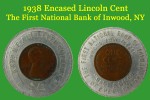
-
1938 Encased Cent from the First National Bank of Inwood (NY)
-

-
A check from the First National Bank of Inwood (NY)
-

-
Medal from the opening of the Brooklyn Bridge in 1883
-

-
1956-D Encased Cent from the Chase Money Museum
-

-
2008 $2 Single Note from the New York Fed
 The U.S. Mint reported that as of December 8, 2014, they had sold a record 42,864,000 one troy ounce American Silver Eagle Bullion coins for all of 2014. This beats the previous record of 42,675,000 coins sold in 2013. Sales of the 2014 bullion coins to authorized dealers will end during the week of December 15.
The U.S. Mint reported that as of December 8, 2014, they had sold a record 42,864,000 one troy ounce American Silver Eagle Bullion coins for all of 2014. This beats the previous record of 42,675,000 coins sold in 2013. Sales of the 2014 bullion coins to authorized dealers will end during the week of December 15. The other announcement was that the U.S. Mint will sell a new product, Coin Discovery Set — An Introduction to Coin Collecting. The set costing $24.95 will include three 2014 Kennedy Half-Dollars in three different finishes—proof, uncirculated and circulating. It will also include two coin tubes for quarters, a magnifying glass, cotton gloves, and a booklet that explains the coin production process. The box will the the size to store U.S. Mint proof sets.
The other announcement was that the U.S. Mint will sell a new product, Coin Discovery Set — An Introduction to Coin Collecting. The set costing $24.95 will include three 2014 Kennedy Half-Dollars in three different finishes—proof, uncirculated and circulating. It will also include two coin tubes for quarters, a magnifying glass, cotton gloves, and a booklet that explains the coin production process. The box will the the size to store U.S. Mint proof sets.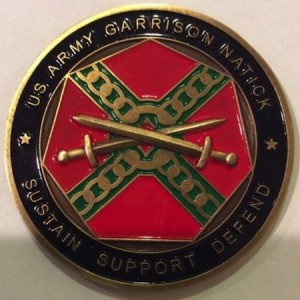

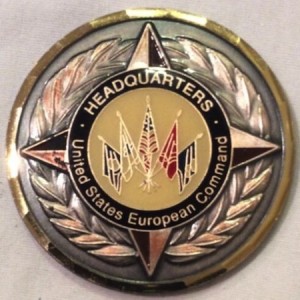

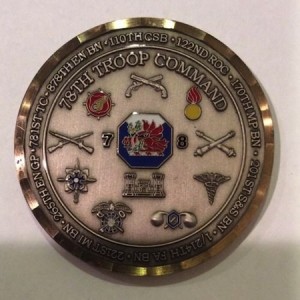

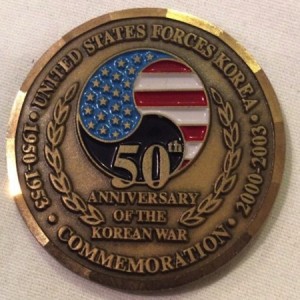


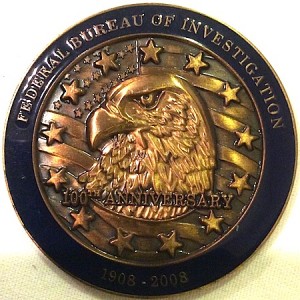


 Over the weekend I attended an estate auction that included coins for sale. While my new business venture concentrates on all vintage collectibles, I am still a collector and continue to look for those interesting items and the good coins to add to my collection. As I was looking over the lots I noticed one had several blue folders of Lincoln cents. The collector in me could not resist and I picked up the folders and started looking.
Over the weekend I attended an estate auction that included coins for sale. While my new business venture concentrates on all vintage collectibles, I am still a collector and continue to look for those interesting items and the good coins to add to my collection. As I was looking over the lots I noticed one had several blue folders of Lincoln cents. The collector in me could not resist and I picked up the folders and started looking.














